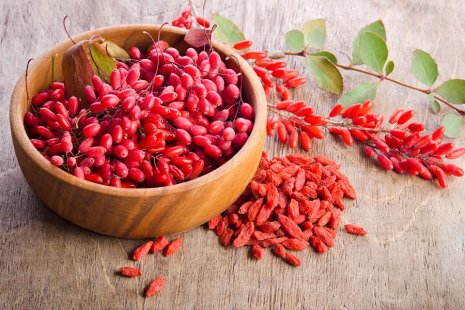
Barberry is one of the resistant shrubs that has the ability to grow and produce in low-interest lands with saline water and needs more attention, while increasing the production capacity of agricultural products, it can also be effective in protecting the soil of the region. consumption of barberry as a fresh eater is not common because of its sour taste. By supplying a variety of products such as jam, marmalade, juice, soft drinks, sauces, jelly,etc., while attracting surplus production on consumption and creating added value, it can be introduced to international markets in the name of Iran. Barberry is an iranian native plant and it’s seedless type has established a reputation for southern khorasan regions, especially Ghaen and Birjand, and has recently been recommended according to the policy of cropping pattern in Kerman province.
Botany Barberry thorny shrub
Barberry is a thorny shrub with a height of 1 to 3 meters and has brittle branches. The height of some cultivars in favorable environments reachesto 6 meters. The plant has a bisexual base and flowers, i.e. each flower has both male and female organs. Barberry flower is composed of 3 pieces, which are located in two rows of annular. Barberry flags are 6 numbers that are placed in 2 rows of 3. The sheets are leathery and non-detachable at a high level, these leaves are smooth in some varieties and serrated in some others. Barberry bush is prickly and its spines are caused by the conversion of leaves, which are widened at the junction of spines to branches.
The types of barberry that have been seen in Iran so far are:
1- Zalzalaki
2- Zarafshani Barshak
3- Common barberry
4- Japanese barberry
Barberry ecological requirement
Temperature
Barberry shrubs, which grow at heights of more than 1,000 meters and in areas with relatively cold and long winters, have more growth and better harvesting . But the intense summer heat in low-lying areas with warm winds is a limiting factor in its climatic adaptation. seedless barberry for producing enough fruit and high yield needs a sunny place with good airflow, and it is also used as a fence and windmill, but hot winds, especially during flowering, strongly affect the production and quality of the fruit.
Due to the late appearance of flowers, frostbite of flowers has rarely occurred, but cold fruits have been seen in the case of late harvesting and early autumn cold. The growth of barberry plants are at 15-18 °C and in different regions usually begins in April and May. Barberry flowers and fruits appear in a heat of about 19-23 degrees Celsius. At temperatures of about 7-11 °C, the period of latent life or dormancy of the plant begins.
This plant is resistant to long winters and remains in life until the heat reaches about 15 degrees Celsius.
Suitable soil
The most suitable growth and development status of barberry has been observed in lime soils with lumy, lumine-sandy or even sandy-lumine soils. This plant can withstand a soil with a pH of about 9. barberry grows well in light lime soils and is somewhat adapted to water and soil salinity, usually used to strengthen the soil around the roots of the plant. In recent years, the use of chemical fertilizer ammonia phosphate has also become common. Mountainous areas with light soil are suitable for growing barberry.
Barberry’s water requirement
Barberry also shows resistance to water deficiency, but the suitable irrigation rate has a significant effect on the harvesting of jumbo and meatierfruits. So the suitable irrigation period can be 12 to 15 days, although according to the visit, it was observed that this irrigation period in some gardens of Birjand and Ghaen will reach 24 days. In the dry years, Farmers harvest barberry even with three irrigations in the garden in summer
. But for more harvesting However, in order to harvest a lot of crops, regular watering should not be avoided for a period of one to two weeks before harvesting after the petals fall.
Barberry farmers believe that irrigation in the time of flowering especially if it is saturated with roots, causes the flower to fall in some regions until early June from the irrigation of barberry.
Barberry Proliferation Methods
Seedless Barberry is proliferated by non-sexual method and usually by pajoush and usually 2-3 year old pajooshes with lengths of 60 to 70 cm and a diameter of one centimeter that are brown are suitable for planting. The best time for separation and planting of pajoushes is late november and early December, preparation and planting of pajoushes in March is also possible, but the probability of getting pajoushes in the autumn is more likely.
The important point is that the roots of the pajoush should not be exposed to the wind when moving, especially in the distances, and in case of transferring to long distances, it is necessary to cover the roots by some wet soil and into a wet cloth or a bag of nylon. Barberry’s
seedlings are planted at intervals of 5×5, 5×4, 4×4 meters from each other and usually Up to 500 barberry seedlings per hectare are required for cultivation.
Although most of the farmers in the southern regions of Khorasan have planted the barberry with more density, and some farmers also plant saffron among the Barberry’s rows.
How to plant barberry
Barberry seedlings are planted in the middle of autumn after harvesting and after they have prepared the ground, although it is recommended that the fertilizer be carried out before planting according to the soil test, but farmers add essential fertilizers (chemical-animal)to the soil to prepare the land and then plow half-deep. Then, the pits are drilled at a size of 50 × 50 ×50 per cm and according to the procedure, a handful of phosphorous fertilizers and nitrogens inside each pit are uniformly mixed with the soil when soiling for planting seedlings.
In some areas with severe winter cold, while soiling ,some straw is poured into the pits so that the roots which are very sensitive to cold, do not freeze. Barberry gardens are constructed on regular forms i.e. triangular or square or rectangular with a distance of 4×4 meters or 5×5 meters. Planting barberry seedlings in early spring is also possible, but shrubs are more likely to catch in the autumn, whether the roots have more time to grow.






User comments